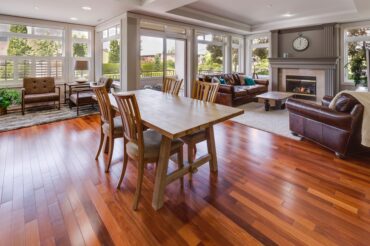
 If you’re a homeowner with hardwood floors, you probably already know that colder weather tends to dry out wood floors. When cooler weather hits, homeowners turn on the furnace which dries out the air in your home. A lack of humidity causes the boards to shrink. It’s not a huge problem, but it can cause gaps between planks, squeaking, or even surface cracks. It is important to remember that shrinkage is not a flaw in the wood nor an installation related problem. It is simply the wood reacting naturally to changes in the environment, however there’s good news! You can take precautionary measures to minimize the effects of winter’s dryness.
If you’re a homeowner with hardwood floors, you probably already know that colder weather tends to dry out wood floors. When cooler weather hits, homeowners turn on the furnace which dries out the air in your home. A lack of humidity causes the boards to shrink. It’s not a huge problem, but it can cause gaps between planks, squeaking, or even surface cracks. It is important to remember that shrinkage is not a flaw in the wood nor an installation related problem. It is simply the wood reacting naturally to changes in the environment, however there’s good news! You can take precautionary measures to minimize the effects of winter’s dryness.
Humidifier Tips
The most important thing you can do is control the humidity levels in your home so that the wood flooring doesn’t become too dry. Don’t forget to turn your humidifier on and set it properly for the winter season. To do that you must know the correct levels of humidity that are ideal for your home to be set at. Indoor air humidity levels must be between 35% and 55%. This will keep common complications, like gapping, to a minimum. Additionally, narrower boards, more stable species of wood, quartersawn boards, or a combination of these features will also reduce these complications. Most homeowners simply accept the gaps as part of owning a wood floor.
Wood Has a Comfort Level
Wood floors do best when the humidity and temperature indoors are kept at controlled levels. In Kansas and Missouri, a humidity range of 35% – 50% and a temperature range between 60°F- 80°F are recommended.
Flooring that is manufactured from exotic wood species is more demanding than flooring made from domestic woods. For this reason, a set of additional requirements has to be met when installing and maintaining an exotic hardwood floor. Indoor air humidity levels must be in the range of 50 – 70%, and air temperature should be kept in the range of 65°F – 75°F.
Then there’s engineered hardwood flooring. It’s made of layers of wood, bonded together with adhesives, under intense heat and pressure. Because of this process, engineered hardwood flooring isn’t affected by humidity as much as solid hardwood. It doesn’t shrink or expand as much so the problems are mitigated.
SVB Minimizes Wood Expansion and Contraction Problems
At SVB, we know wood. We know wood will change with the environment. That’s why we do everything possible to reduce the reaction our wood floors will have to environmental changes. Here are few of the advantages you’ll get with an SVB wood floor:
We only use reputable mills, which kiln dry and transport the wood per NWFA standards for Kansas and Missouri – between 6% and 8% moisture content.
We only buy from wholesalers who have climate controlled warehouses.
We log relative humidity readings and moisture content readings on your home and wood after delivery to make sure it has the correct relative humidity.
We acclimate the wood to our region before installation.
We log moisture content readings of your subfloor and flooring before installation to make sure it falls within guidelines set forth by the NWFA.



